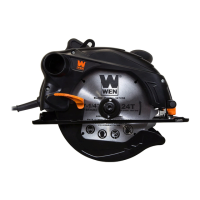OPERATION
OPERATING THE SAW
1. Hold the tool firmly with both hands, using both the front grip and the rear handle. Avoid placing your hand on
the workpiece while making a cut. If both hands are holding the saw, they cannot be cut by the blade.
2. Stand to the left side of the saw. NEVER operate the saw standing to the right of the saw. Do not positioning
yourself so that you’re in the path of chips and wood dust being ejected from the saw.
3. Set the front portion of the saw’s base on the workpiece to be cut without letting the blade contact the workpiece.
Position the saw with its motor facing toward the larger section of board that isn’t falling away when cut. Align the
line-of-cut indicator notch (Fig. 5) on the base with your guideline.
4. Turn on the saw and let the blade reach full speed before guiding the saw into the work piece.
5. Ease the tool forward over the workpiece surface, keeping it flat and advancing smoothly while following your
guideline until sawing is completed.
• Do not force the saw forward too quickly in order to try and hurry up the process. Let the tool work at its own
pace.
• To make sawing easier and safer, be sure to move the tool forward gently in a straight line. Never force or twist
the saw during operation. Forcing or twisting the tool will result in overheating the motor and will increase the
chances of dangerous kickback, possibly causing severe personal injury.
• If the cut fails to properly follow your intended cut line, release the switch trigger, wait for the blade to stop, and
then remove the tool. Realign saw on a new cut guideline and start the cut again. Do not attempt to turn or force the
tool back to the cut line. Doing so may bind the blade and lead to dangerous kickback and possible serious injury.
6. Once the cut is complete, release the switch trigger. Wait for the blade to completely stop. Check that the lower
blade guard has returned to position surrounding the blade. Now you can safely set the saw down out of the way.
Disconnect the saw from the power source.
CROSS-CUTTING AND RIP CUTTING
Cross-cutting means cutting directly across the grain of a piece of wood and it is likely the most common type of cut
done with a circular saw. As mentioned in “Installing the Rip Guide,” cutting wood lengthwise, or with the grain, is
referred to as rip cutting (or simply “ripping”). Both types of cuts are performed in the same manner with the excep-
tion of the methods used to support and secure the work piece for cutting.
BEVEL CUTTING
Bevel cuts are made using the same technique as crosscuts and ripping described in the previous section. The differ-
ence is that the blade is set at a tilted angle between 0° and 45°. A bevel cut made at an angle to the edge of a board
is called a compound miter. Some compound cuts may require you to manually retract the lower guard to allow the
blade to enter into and/or through the cut.
There are tools better suited for bevel and compound cuts than the hand-held circular saw. Although the inner
line-of-cut indicator notch aids the operator in following the cut’s guideline, the tilted motor housing sometimes
obstructs the operator’s ability to see the blade, making accurate cuts difficult. Before taking on a project with nu-
merous compound or bevel cuts it’s suggested that the inexperienced saw user spends time making practice cuts in
scrap lumber to become familiar with and overcome difficulties associated with compound/bevel cutting.
13

